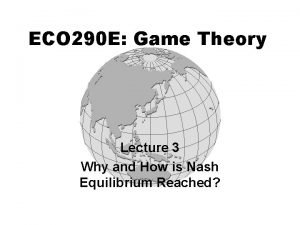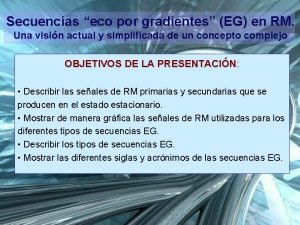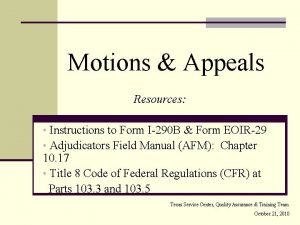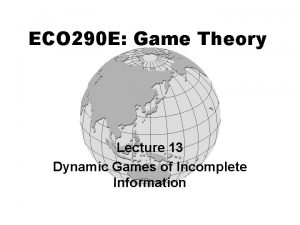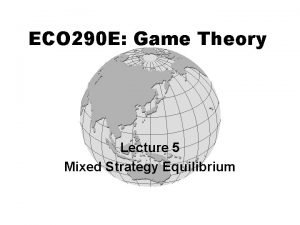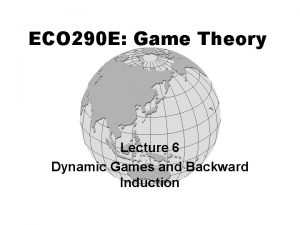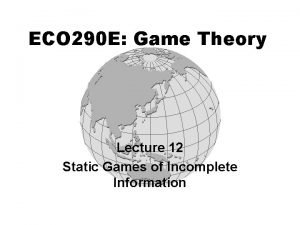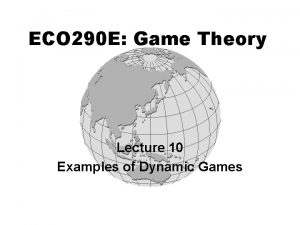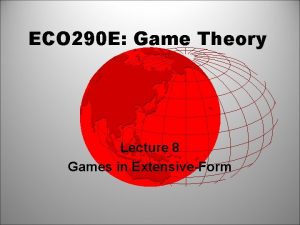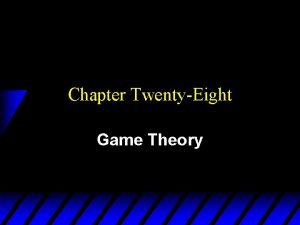ECO 290 E Game Theory Lecture 3 Why











- Slides: 11

ECO 290 E: Game Theory Lecture 3 Why and How is Nash Equilibrium Reached?

Three Reasons for NE 1. By rational reasoning 2. A result of discussion 3. A limit of some adjustment process Þ Which factor serves as a main reason to achieve Nash equilibrium depends on situations.

1. Rationality • Players can reach Nash equilibrium only by rational reasoning in some games, e. g. , Prisoners’ dilemma. • However, rationality alone is often insufficient to lead to NE. (see Battle of the sexes, Hawk-Dove game, etc. ) • A common (and correct) belief about future actions combined with rationality is enough to achieve NE. Þ 2 and 3 help players to share a correct belief.

Focal Point • A correct belief may be shared by players only from individual guess. Þ Class room experiments, i. e. , Choose one city in Japan! (you will win if you can choose the most popular answer) Þ Most of the students named “Tokyo. ” • Like this experiment, there may exist a Nash equilibrium which stands out from the other equilibria by some reason. Þ Focal Point (by Thomas Schelling)

2. Self-Enforcing Agreement • Without any prize or punishment, verbal promise achieves NE while non equilibrium play cannot be enforced. Þ NE=Self-Enforcing Agreement Example: Prisoners’ Dilemma • Even if both players promise to choose “Silent, ” it will not be enforced since (S, S) is not a NE.

3. Repeated Play • Through repeated play of games, experience can generate a common belief among players. Example: Escalator • Either standing right or left can be a NE. Example: Keyboard • “Qwerty” vs. “Dvorak” Þ History of adjustment processes determine which equilibrium is realized: Economic history has an important role. Þ “Path Dependence” (by Paul David)

Roles of Social Science • Analyze the frequently observed phenomena and explain the reason. Þ NE serves as a powerful tool. • Predict what will happen in the future. Þ Although it is usually difficult to make a one-shot prediction, NE may succeed to predict the stable situation after some (long) history of adjustment processes.

What is Rationality? • A player is rational if she chooses the strategy which maximizes her payoff given other players’ strategies. The Definition implies that a rational player • takes a dominant strategy whenever it is available. • never takes (strictly) dominated strategies.

Dominance • Let x and y be feasible strategies for player i. Then strategy x is strictly dominated by y if the following is satisfied: • That is, x is strictly dominated by y when y gives i strictly higher payoffs than x does irrespective of other players’ strategies.

Iterated Elimination of Strictly Dominated Strategies Player 2 Left Player 1 Up Middle 0 1 Down 2 1 3 0 Right 1 0 0 2

Rational Solution • Step 1: “Right” is strictly dominated by “Middle, ” so player 2 never takes “Right. ” • Step 2: Given the belief that Player 2 never takes “Right, ” “Down” is strictly dominated by “Up. ” Therefore, Player 1 will not take “Down. ” • Step 3: Given the belief that Player 1 will not take “Down, ” “Left” is strictly dominated by “Middle. ” Therefore, Player 1 will not take “Left. ” • Step 4: Only (Up, Middle) is survived after the iterated elimination process! Þ This reasonable solution coincides with NE.
